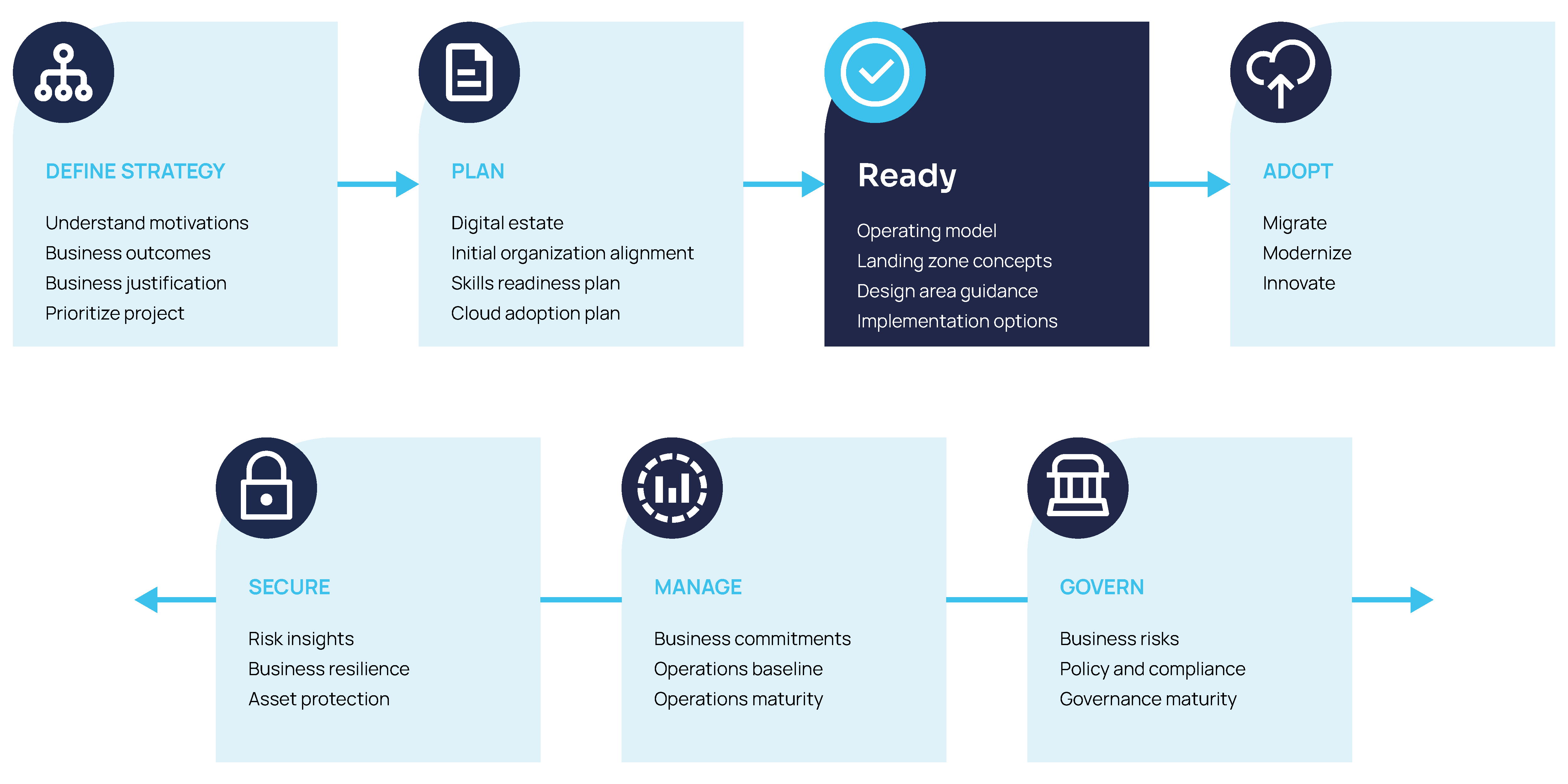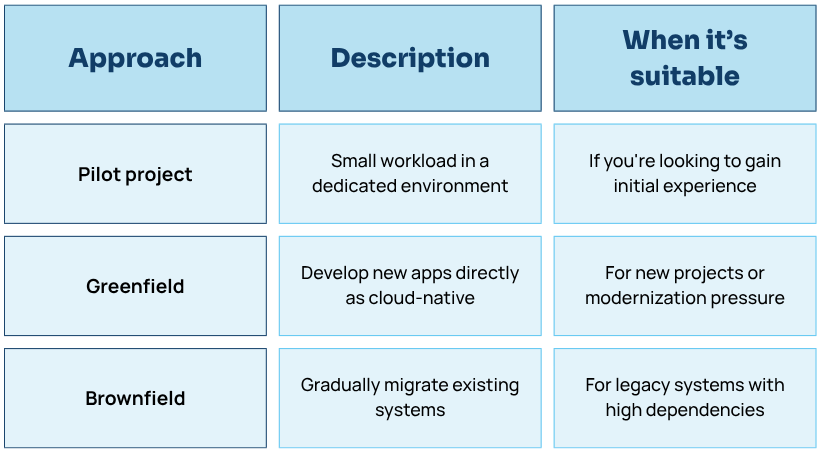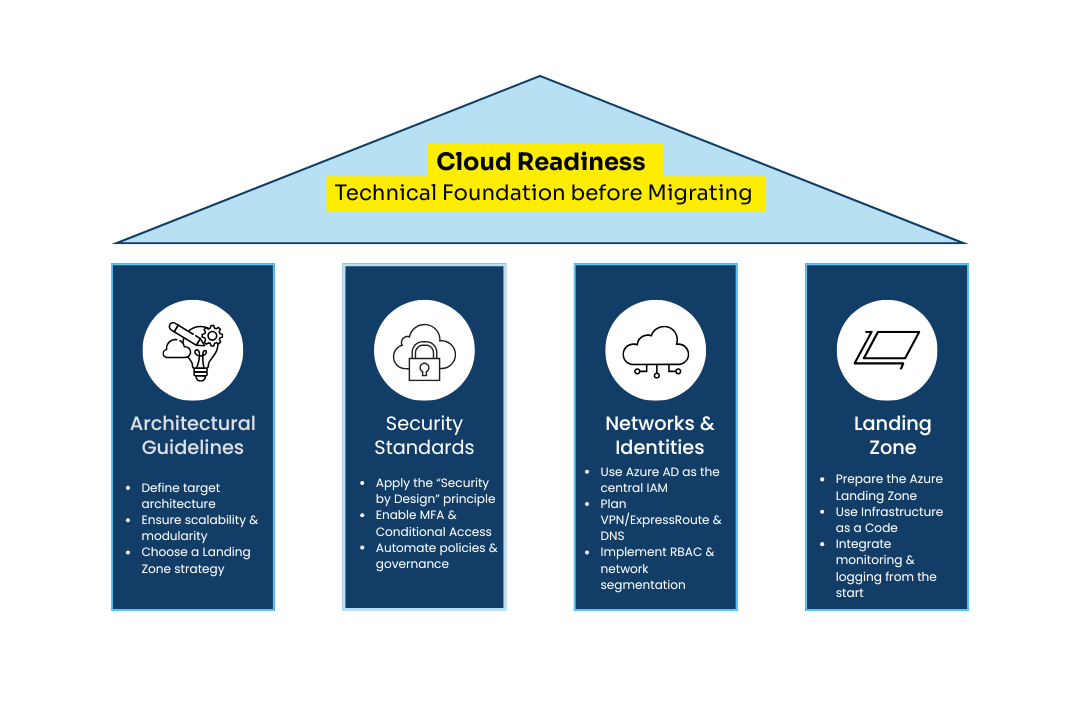Successful Migration & Modernization with the Microsoft Cloud Adoption Framework
You've made the decision to move to the cloud and created a solid plan – now it’s time for technical implementation. But before migrating your first workload, you need a strong foundation: networks, identities, security policies and architectural principles must be well-prepared and aligned. In this article, we’ll show you how to build a technical base that is scalable, secure and future-proof – with clear recommendations from the Microsoft Cloud Adoption Framework.

Microsoft Cloud Adoption Framework
Why Technical Preparation Is So Important
Even the best strategies and roadmaps are of little help if the technical foundation is missing. A cloud migration without a well-thought-out base can lead to outages, security vulnerabilities or inefficient operations. The goal of the Ready phase in the Cloud Adoption Framework is therefore to create the key prerequisites – both organizational and technical.
This includes:
- Defining architectural guidelines
- Establishing security standards
- Preparing networks and identities
- Creating a scalable platform, such as with a Landing Zone
🔧 The Operating Model – Structure for Technology & Operations
A central element for success in the cloud is the Cloud Operating Model. It defines how IT teams will work together in the future, outlines roles and responsibilities, and ensures that security, compliance, and operational technologies are seamlessly integrated.
A well-thought-out operating model answers key questions such as: Who manages identities and access rights? Who is responsible for network architecture and security? And how is support handled after the migration?
💡 Tip: Involve business departments early in the process—for example, through workshops or process simulations. This ensures that the operating model is not only technically sound but also practical and effective in day-to-day operations.
Azure Landing Zones – The Technological Foundation
A landing zone is the central “touchdown area” for your workloads in the cloud – your first production-ready environment where all essential foundational components are already in place. It forms the technological backbone of your cloud initiative and ensures that new resources can be deployed in a standardized, secure, and reusable manner. At the same time, it guarantees compliance with security and regulatory requirements while offering the scalability needed to keep up with growing demands.
If you're currently planning your cloud migration, our Azure Landing Zone solution is the ideal starting point. It provides you with a pre-structured, secure, and scalable cloud environment based on proven best practices, tailored precisely to your organization’s needs. This way, you establish a solid and future-proof cloud foundation from the outset.
💡 Tip: Start with a “Start Small, Expand” approach – a lean and well-structured landing zone – and gradually scale it as your cloud initiative matures and your organizational cloud capabilities grow.
Design Guidelines: Network, Identity, Security
To ensure your environment runs stably and remains secure, the following technical areas should be prioritized during the Ready phase:
🔗 Network
- Clearly define the architecture (e.g., hub-and-spoke or mesh)
- Set up VPNs or ExpressRoute for secure connection to your on-premises environment
- Plan DNS, IP address spaces, and subnets consistently
👤 Identity & Access
- Use Azure Active Directory as the central identity and access management system
- Enable Multi-Factor Authentication (MFA) and Conditional Access
- Implement Role-Based Access Control (RBAC)
🛡️ Security by Design
- Integrate security policies directly into infrastructure templates
- Enable network segmentation, firewalls, and logging
- Start early with Microsoft Defender for Cloud
💡 Tip: Automate security configurations using Infrastructure as Code, e.g., with Bicep, Terraform or Azure Blueprints.
🚀 Getting Started: Pilot, Greenfield, or Brownfield?
How you approach cloud adoption depends on your current state and goals:

🎯 Best Practice: Combine MVP (Minimum Viable Product) approaches with clear success criteria – this helps you achieve fast learning and internal acceptance.
❓ Frequently Asked Questions about Technical Readiness and Azure Landing Zones
When should I start technical preparation?
As soon as strategic decisions regarding cloud adoption have been made, technical readiness should begin—ideally in parallel with organizational planning. Delaying technical preparation often leads to project delays and unnecessary complexity during the migration phase.
Is an Azure Landing Zone suitable for smaller businesses?
Absolutely. Especially with a "Start Small, Expand" approach, smaller organizations benefit from clear structures, defined security standards and automation. The solution is modular and can scale with your cloud maturity and growing requirements.
How long does it take to implement a Landing Zone?
Depending on your starting point and complexity, implementation can take anywhere from a few days to several weeks. Our standardized, fixed-price solution ensures maximum transparency, clear project phases and predictable outcomes.
Can existing systems and networks be reused?
Yes – through hybrid network concepts like VPN or ExpressRoute, on-premises environments can be securely and reliably connected. Integration of existing IT infrastructure is considered early in the Landing Zone planning process.

Conclusion: Cloud Readiness Starts with the Foundation
Moving to the cloud is more than a migration – it starts with a new technical mindset. Those who now invest in the right architecture, governance and security are laying the groundwork for a robust, scalable and future-proof cloud environment. With the Microsoft Cloud Adoption Framework and a well-prepared Landing Zone, this transition can be approached in a structured and secure way.
💡 Don’t want to start from scratch?
Our Azure Landing Zone provides a standardized, secure, and ready-to-use environment – tailored precisely to your organization’s needs.
📅 Coming Next Week: Migration & Modernization
In part four of our series, we’ll focus on the actual transition: Which migration strategies are available? How do tools like Azure Migrate work? And how can you quickly launch with an MVP or pilot project? Now it gets hands-on!
